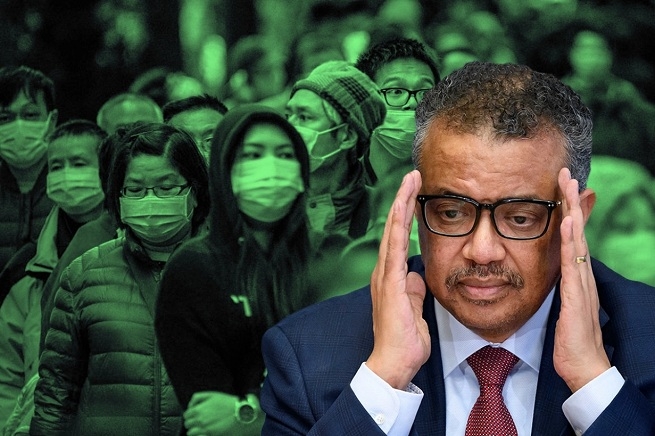Worst yet ahead of us: WHO chief on COVID-19
Date :22-Apr-2020

GENEVA :
The coronavirus has a very dangerous combination like the 1918 flu that killed up to 100 million people globally, says Tedros Adhanom Ghebreyesus
TEDROS Adhanom Ghebreyesus, Director-General of the World Health Organisation (WHO), warned that “the worst is yet ahead of us” in the coronavirus pandemic that has infected millions and killed thousands across the globe. Addressing the media here on Monday, the WHO chief said: “Trust us. The worst is yet ahead of us... Let’s prevent this tragedy. It’s a virus that many people still don’t understand,” the ‘Evening Standard’ newspaper reported. “There is no secret in WHO because keeping things confidential or secret is dangerous. It’s a health issue.
“This virus is dangerous. It exploits cracks between us when we have differences,” he added. Ghebreyesus said that the US Centres for Disease Control and Prevention (CDC) staff have been seconded to work with his agency, suggesting that was a sign of the WHO’s transparency. “Having CDC staff means there is nothing hidden from the US from day one” the WHO chief said, adding: “Our CDC colleagues also know that we give information immediately to anyone.” In one of his starkest comparisons yet, the UN health agency chief also alluded to the Spanish Flu more than a century ago, reports the ‘Evening Standard’ newspaper. He said the coronavirus has a “very dangerous combination like the 1918 flu that killed up to 100 million people”.
Ghebreyesus called the illness “Public Enemy Number One” and said: “We have been warning from day one: this is a devil that everybody should fight.” As of Tuesday morning, a total of 1,70,324 people have died of the disease, while the global number of coronavirus cases stood at 24,77,426, according to the Johns Hopkins University. The US with 42,335 deaths and 7,87,370 cases currently accounts for the highest number of infections and fatalities in the world. The US State Department has said the WHO was too late in sounding the alarm over COVID-19 and is overly deferential to China. It questioned why it did not pursue a lead from Taiwan flagged up on December 31 about reports of atypical pneumonia in Wuhan Debate has raged over the significance of Taiwan’s email, which informed the WHO of the reports from Wuhan, and of at least seven patients being isolated -- something that would not be necessary for a non-infectious disease.
The United States said on Thursday that it was “deeply disturbed that Taiwan’s information was withheld from the global health community, as reflected in the WHO’s January 14, 2020 statement that there was no indication of human-to-human transmission”. But Tedros insisted that the WHO was already aware of reports emanating from Wuhan -- and said Taiwan’s email was only seeking further information. “One thing that has to be clear is the first email was not from Taiwan. Many other countries were already asking for clarification. The first report came from Wuhan,” said Tedros.
“Taiwan didn’t report any human-to-human transmission,” he stressed. WHO emergencies director Michael Ryan said the email made no reference to anything beyond what had already been reported in news media. “Clusters of atypical pneumonia are not uncommon. There are millions of cases of atypical pneumonia around the world in any given year,” he explained. Ryan said that the WHO tweeted the existence of the event in Wuhan on January 4, and on January 5 provided “detailed information on the epidemic” which all countries could access. Tedros also urged leaders not to exploit the pandemic for their own political capital. “Don’t use this virus as an opportunity to fight against each other or score political points,” he said. “It’s like playing with fire. It’s the political problem that may fuel further this pandemic.”

Rush to ease virus rules could cause resurgence: WHO
Governments must remain vigilant to stop the spread of the virus and the lifting of lockdowns and other social distancing measures must be done gradually and strike the right balance between keeping people healthy and allowing economies to function, said Dr Takeshi Kasai, the WHO regional Director for the Western Pacific
BANGKOK :
THE World Health Organisation said on Tuesday that rushing to ease coronavirus restrictions will likely lead to a resurgence of the illness, a warning that comes as Governments start rolling out plans to get their economies up and running again. “This is not the time to be lax. Instead, we need to ready ourselves for a new way of living for the foreseeable future,” said Dr. Takeshi Kasai, the WHO regional Director for the Western Pacific. He said that Governments must remain vigilant to stop the spread of the virus and the lifting of lockdowns and other social distancing measures must be done gradually and strike the right balance between keeping people healthy and allowing economies to function. Despite concerns from health officials, some US States on Monday announced aggressive reopening plans, while Boeing and at least one other US heavy-equipment manufacturer resumed production. Elsewhere around the world, step-by-step reopenings were underway in Europe, where the crisis has begun to ebb in places such as Italy, Spain and Germany. Australia said on Tuesday that it will allow the resumption of non-urgent surgeries from next week as health authorities grow more confident that hospitals there won’t be overwhelmed by COVID-19 patients. The reopenings come as politicians grow weary of soaring unemployment numbers and the prospect of economic depression. Asian shares followed Wall Street lower on Tuesday after US oil futures plunged below zero because of a worldwide glut as factories, automobiles and airplanes sit idled. Businesses that start operating again in the US are likely to engender good will with President Donald Trump at a time when his administration is doling out billions in relief to companies. Trump has been agitating to restart the economy, singling out Democratic-led States and egging on protesters complaining that the shutdowns are destroying their livelihoods and trampling their rights. In several States — most of them Republican-led — Governors said that they had seen signs that the coronavirus curve was flattening, making it possible to start reopening businesses and public spaces. Texas on Monday began a week of slow reopenings, starting off with State parks, while officials said that later in the week, stores would be allowed to offer curbside service. But Governors from many other States said they lacked the testing supplies they need and warned they could get hit by a second wave of infections, given how people with no symptoms can still spread the disease. Boeing said it was putting about 27,000 people back to work this week building passenger jets at its Seattle-area plants, with virus-slowing precautions in place, including face masks and staggered shifts. Boeing’s shutdown went into effect March 25 after workers tested positive for the virus and an inspector for the company died.